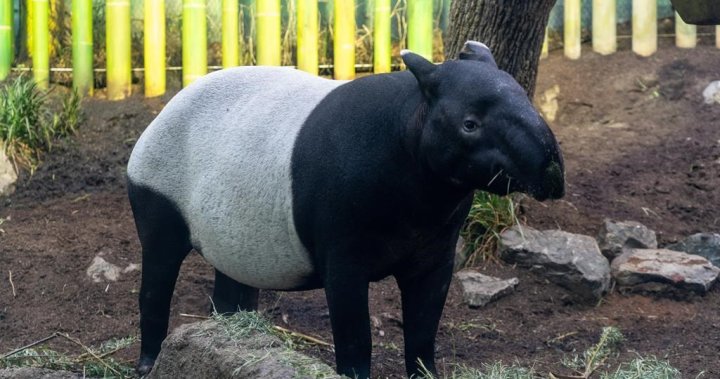The Calgary Zoo’s Watermelon Watch: A Story of Conservation and Cuteness
The Calgary Zoo is abuzz with anticipation as it awaits the arrival of a new addition: a Malayan tapir calf, expected to make its debut sometime between mid-July and mid-August. This delightful event carries significant weight, not only for the zoo but also for the conservation efforts aimed at protecting this endangered species. Four-year-old Sempurna, the expectant mother, and 23-year-old Tanuck, the father, are playing crucial roles as ambassadors for their kind, highlighting the plight of Malayan tapirs in the wild.
Malayan tapirs, the largest of the four tapir species, are instantly recognizable by their distinctive black and white coloration. Adults sport a black front and hindquarters, separated by a broad, white band that stretches from their shoulders to their rumps. This unique pattern provides excellent camouflage in their native rainforest habitat. However, the real showstopper comes in the form of their offspring. Baby tapirs are born with a coat of brownish-black fur adorned with white stripes and spots, resembling a miniature watermelon on four legs. This adorable camouflage helps them blend seamlessly into the dappled light of the forest floor, protecting them from predators.
The impending arrival of Sempurna’s calf is a cause for cautious optimism at the Calgary Zoo. The zookeepers are closely monitoring Sempurna’s pregnancy, providing her with the best possible care to ensure a successful birth. As the due date approaches, the zoo plans to launch the #WatermelonWatchYYC campaign on social media, inviting the public to share in the excitement and learn more about these fascinating creatures. The gestation period for Malayan tapirs is typically around 13.5 months, placing the expected arrival window between mid-July and mid-August.
The birth of a Malayan tapir calf is not merely a heartwarming event; it’s a significant victory for conservation. Wild populations of Malayan tapirs face a daunting reality in Southeast Asia. Habitat loss due to deforestation, driven by agricultural expansion and logging, is shrinking their natural homes. Poaching for their meat and hide poses an additional threat, as does conflict with humans, particularly in areas where tapirs raid crops. These combined pressures have led to a rapid decline in Malayan tapir numbers, placing them on the IUCN Red List as endangered.
The Calgary Zoo’s commitment to Malayan tapir conservation extends beyond breeding programs. The zoo actively participates in research and education initiatives to raise awareness about the challenges these animals face in the wild and promote conservation efforts. By providing a safe haven for these magnificent creatures, the zoo contributes to the long-term survival of the species and inspires visitors to appreciate the importance of biodiversity conservation.
The #WatermelonWatchYYC campaign is not just about celebrating the cuteness of a baby tapir; it’s about raising awareness for a species on the brink. It’s about reminding us that conservation isn’t just about protecting animals in zoos; it’s about ensuring their survival in the wild. It’s about recognizing that every individual, every birth, represents a glimmer of hope for a species struggling to survive. As we eagerly await the arrival of Sempurna’s calf, we’re reminded that the future of these magnificent creatures lies in our hands. The Calgary Zoo’s efforts, combined with the support of the public, can help ensure that Malayan tapirs continue to roam the rainforests of Southeast Asia for generations to come.

